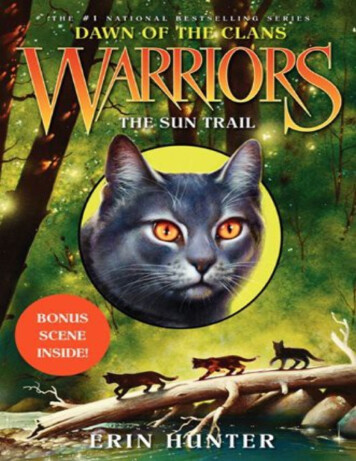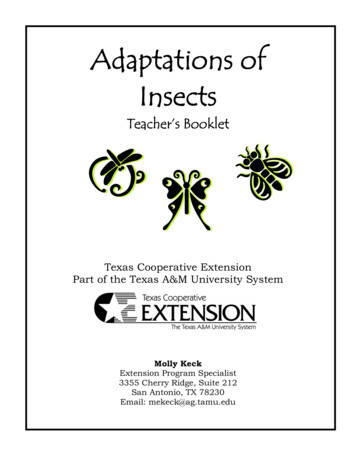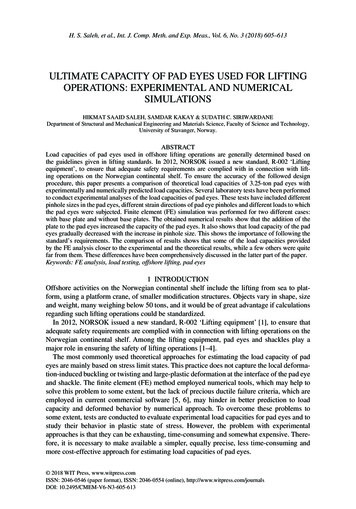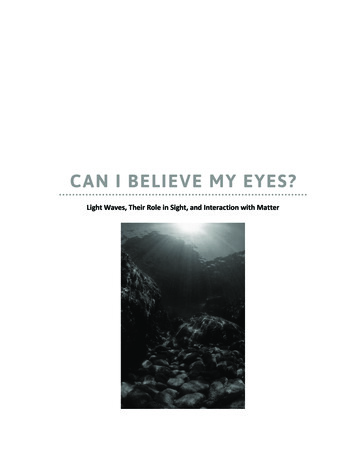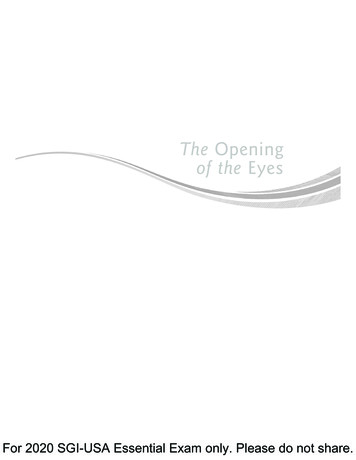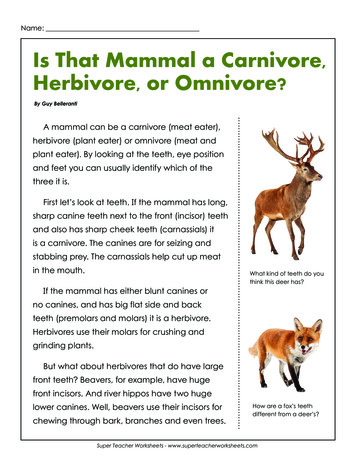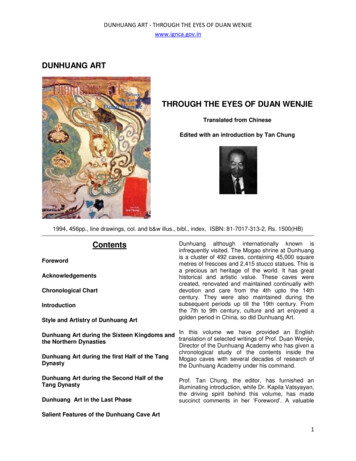
Transcription
DUNHUANG ART - THROUGH THE EYES OF DUAN WENJIEwww.ignca.gov.inDUNHUANG ARTTHROUGH THE EYES OF DUAN WENJIETranslated from ChineseEdited with an introduction by Tan Chung1994, 456pp., line drawings, col. and b&w illus., bibl., index, ISBN: 81-7017-313-2, Rs. cal ChartIntroductionStyle and Artistry of Dunhuang ArtDunhuang although internationally known isinfrequently visited. The Mogao shrine at Dunhuangis a cluster of 492 caves, containing 45,000 squaremetres of frescoes and 2,415 stucco statues. This isa precious art heritage of the world. It has greathistorical and artistic value. These caves werecreated, renovated and maintained continually withdevotion and care from the 4th upto the 14thcentury. They were also maintained during thesubsequent periods up till the 19th century. Fromthe 7th to 9th century, culture and art enjoyed agolden period in China, so did Dunhuang Art.Dunhuang Art during the Sixteen Kingdoms and In this volume we have provided an Englishtranslation of selected writings of Prof. Duan Wenjie,the Northern DynastiesDirector of the Dunhuang Academy who has given achronological study of the contents inside theDunhuang Art during the first Half of the TangMogao caves with several decades of research ofDynastythe Dunhuang Academy under his command.Dunhuang Art during the Second Half of theTang DynastyDunhuang Art in the Last PhaseProf. Tan Chung, the editor, has furnished anilluminating introduction, while Dr. Kapila Vatsyayan,the driving spirit behind this volume, has madesuccinct comments in her ‘Foreword’. A valuableSalient Features of the Dunhuang Cave Art1
DUNHUANG ART - THROUGH THE EYES OF DUAN WENJIEwww.ignca.gov.inAppendix 1information on all the Mogao caves has been added.Conservation and Copying of Cultural Relics atDunhuang Appendix 2Colour and black and white photographs and finesketches by Vineet Kumar supplement the text.Periodization of the Mogao CavesThe Indira Gandhi National Centre for the Arts iscommitted to exploring all dimensions of art. It feelsprivileged to place before art historians and artlovers of the English-speaking world first-handinformation about this unique art gallery going backto one-and-a-half millennia.A Glimpse of the Mogao CavesGlossaryBibliographyTAN CHUNG is Professor Consultant at the Indira Gandhi National Centre for the Arts. He retired fromJNU as Professor of Chinese. He has authored important books on China, e.g., China and the Brave NewWorld and Triton and Dragon. Through his writings and his associations, with academic institutionsProf.Tan Chung has provided a fresh outlook for viewing China's past, different from some western criticalcommentaries. 1994 Indira Gandhi National Centre for the Arts, New DelhiCopublishers : Abhinav Publication,E-37, Hauz Khas, New Delhi - 110 016.All rights reserved. No part of this book may be reproduced or transmitted in any form or by any means,electronic or mechanical, including photocopy, recording or by any information storage and retrievalsystem, without prior permission in writing.2
DUNHUANG ART - THROUGH THE EYES OF DUAN WENJIEwww.ignca.gov.inForewordMogao Grottoes, Dunhuang --- the very name conjures up a vision of caves lying in the proximity of sanddunes across the Gobi desert almost touching Turfan and Turkistan. Ever since the discovery of thesecaves, they have attracted scholars from far and wide. For me too, this was a dream. For years I hadperused the reproductions of Dunhuang in many books, looked at the materials brought by Sir AurelStein, now in the National Museum, and hoped that one day it would be possible to see the originals intheir natural setting. Such an opportunity arose when I was invited to attend an International Symposiumon Dunhuang organised by the Dunhuang Academy in 1990. I took this journey by plane and not on footor on camel back, not through the arduous paths of travellers, pilgrims and traders who had crossed themountain passes and deserts, and yet the dramatic change in the landscape was evident. Flying over theGobi desert and the dark-green rocky jade cliffs, gradually we were amongst sand-dunes conglomerates.A vast panorama of caves by the thousands opened up until I found myself suddenly in front of theDunhuang Caves --- the caves which had called many monks and laymen for centuries. As I entered thisdream-world of half-luminosity, I remembered a poem written by a contemporary Buddhist scholar, ZhaoPuchu, namely:"Angels hovering the sky with joy,Enlightened path lies for men's choice,Hands with umbrellas and garlands,Tender is the preacher's exalted glance.They fly non-stop through eternity,With delight, devotion and dignity,I am happy to come for pilgrimage,To this jewel of cultural heritage."Dunhuang epitomizes the mutual dialogue between India and China over the centuries. The creativeenergies of each, in symbiosis but distinct, are in evidence here in a manner which speaks of acontinuous and sustained dialogue at multiple levels of communications between two great cultures. Theopening and extension of the Silk Route served as a bridge for direct contact between the two countriesby way of trade and commerce. But there was also a constant stream of religious, cultural and deeperspiritual communication. Buddha and his teachings were the inspiration for the goals of this journey.Monks from India had travelled to China while many from China also travelled to India to collect Buddhistscriptures. This interchange flowered in many ways in philosophy, literature and poetry. It also manifesteditself in line and colour, mass and volume in terracotta and stucco statues, frescoes and murals in thisbreath-taking impressive group of 492 caves covering 45,000 square metres of mural paintings, 2,415stucco images of the Buddha and Bodhisattvas. Historically the span of creative activity is equallyimpressive, extending from the fourth to the fourteenth century.What a treasure and what a privilege to be able to view these caves which had been closed to the publicfor many decades! As I walked through these caves and looked at the wall paintings, stucco figures andthe terracottas, I realised that some of the materials in these caves, particularly manuscripts, silk banners3
DUNHUANG ART - THROUGH THE EYES OF DUAN WENJIEwww.ignca.gov.inand other antiquities were today distributed in many repositories of the world including Italy, Germany,United Kingdom, Russia and India. For the art historians and scholars of Buddhist studies, this material,both in situ and that which lies fragmented in many parts of the world, is an invaluable world heritagecomparable to the artistic creativity evidenced in Ajanta in India.Since the establishment of the Dunhuang Academy in 1944, two scholar-painters along with manyassociates have been copying these paintings for many decades. Professor Chang Shuhong andProfessor Duan Wenjie have lived in these caves as custodians, art-historians and painters. Theiridentification with these caves and their contents is so complete that one cannot think of dissociating theDunhuang caves from Professor Duan Wenjie and his distinguished predecessor Professor ChangShuhong.Although there has been much critical literature on Dunhuang in English and other European languagesthere was the need to have the authentic voice of a Chinese with a distinct Chinese viewpoint in theinterpretation of Dunhuang. I was aware that Prof. Duan Wenjie had written a book on Dunhuang whichhe had graciously presented to me. I took courage to request Professor Duan to permit IGNCA totranslate his work into English for publication. My colleague, Professor Tan Chung, undertook this difficulttask and the volume is before us.We have brought out this volume as a partial fulfilment of the cherished goals of the Indira GandhiNational Centre for the Arts to encompass achievements of art and culture of humankind. The volume isdivided into three parts. First, the "Introduction" by Professor Tan Chung provides an overview of thehistory of Dunhuang, of Dunhuang becoming the celebrated repository of wall-paintings and stuccostatues, of the Dunhuang Institute and of Professor Duan's contribution to Dunhuang art. The second partwhich is also the main part of the volume contains the English translation of selected articles of ProfessorDuan, mostly from his volume in Chinese. As his essays were written at different times, repetition ofcontents is unavoidable. We have done a selection not only to keep the repetition to the minimum butalso to ensure that the volume speaks to a larger readership. The third part is a brief description of eachof the 492 caves of the Mogao Grottoes which is largely an abridged translation of the Chinese materialssupplied by the Dunhuang Academy which, I am told, is the labour of love of Professor Shi Weixiang who,like Professor Duan, I had the pleasure to meet both at Dunhuang and again in New Delhi in 1991, whenthey came as the honoured guests of IGNCA.Through this book, perhaps we are attempting to communicate the vision and the distinctive approach ofProfessor Duan to this great monument of world cultural heritage. I have no doubt that this volume willmake a distinct contribution to the critical literature on Dunhuang and it is hoped that the DunhuangAcademy will sponsor and promote further such studies.I am glad that this volume is being released to coincide with the Golden Jubilee Celebrations of theDunhuang Academy in August 1994. I offer this volume as a token of our felicitations and greetings to oursister institute. Although the Dunhuang Academy is fifty years old, it is full of youth and maturity. I have nodoubts that it will grow and provide more avenues of exploration of the heritage.Kapila VatsyayanNew DelhiJune, 19944
DUNHUANG ART - THROUGH THE EYES OF DUAN WENJIEwww.ignca.gov.inAcknowledgementsThis Book comprising the essays of Professor Duan Wenjie on Dunhuang art cherishes a strong desire topopularize information about the unique art treasure of Dunhuang among the English language readersboth in India and abroad. This desire was first conceived by Dr. Kapila Vatsyayan during her visit toDunhuang in 1990. There is the Chinese saying that while drinking water from the well we should notforget those who have dug it. That is how this volume owes to Dr. Vatsyayan who has guided the processof production of this volume and rendered enormous help to its fruition.This volume is the maiden work of the Cell of Sino-Indian Studies (now renamed as East Asian StudiesProgramme) of Indira Gandhi National Centre for the Arts (IGNCA). It is the result of collective labour.Initially, I had the help of three young scholars: Miss Sonu Agnihotri, Mrs. Bagyalakshmi and Dr. (Miss)Rimli Bhattacharya. Sonu and Bagyalakshmi had spent the best part of a year familiarizing themselveswith the subject and with the technical terminology of art and religion involved in translating ProfessorDuan Wenjie's articles into English. While it was an uphill task for them, they also learnt very fast. Iappreciate their contributions, particularly their tolerance for my constant interventions. Translation is noeasy task and translation involving classical Chinese is doubly difficult. Hence the teamwork has meantmy close examination of their drafts and forcing them to accept what I consider better versions of thetranslation. Rimli has helped in editing the English drafts. Another Buddhist scholar, Miss RadhaBanerjee, who joined our Cell a little later was of great help not only for consultations on the subject butalso in the logistics of production work in bringing out the volume. Another research assistant of the Cell,Ms. Nidhi Nagpal, has contributed in the making of the Glossary of our volume. Bagya, Nidhi and Mr.Deepak, who is a late comer in the Cell, jointly contributed their efforts in supplementing the details for thefinal version of the manuscript. Also attached to the Cell were two researchers from the DunhuangAcademy, Mr. Li Chongfeng and Mr. Yang Fuxue, who also contributed to the undertaking. I take thisopportunity to thank them all.It would have been virtually impossible to bring out the book without the cooperation of the DunhuangAcademy, especially its Director, Professor Duan Wenjie. We would have gathered more information andlearnt more about Professor Duan had we had more time and contacts with him. Professor Duan is anextremely busy man to contact. Moreover, his personal modesty virtually blocked all our efforts ingathering greater details of his life and work beyond what have already been published.IGNCA is a fine institution. In the first place, it provides the right environment for Sino-Indian studieswhich are oriented to the holistic approach in respect of cultural perspective. Secondly, the researchresources and infrastructural facilities of this institution have provided the surest guarantee for our ventureto be brought out in a relatively short time. All the colleagues of IGNCA who have helped us in this regarddeserve our gratitude.Here, I particularly wish to thank the computer operators Mr. Alfred Joy and Miss Neelima Sareen. Whilewe have all worked on successive drafts of the essays in this book, these drafts have finally beenprocessed through the memory of the personal computer. The present version of this book has journeyedthrough numerous drafts: Miss Santosh Phul, the former, and Miss Rajni Bala, the present Stenographerof the Cell had their share of the collective toil in feeding our original and revised ideas onto the computer,and the electronic typewriter of IGNCA. My sincere thanks are also due to both of them.Mr. Vineet Kumar, who has the rare distinction of an Indian painter with mastery of Chinese paintingstyles, has done a wonderful job in doing the art designing and the sketches of the book. His work hashelped beautify our volume. I extend my gratitude to him. I also wish to add a word of thanks to Ms. ZhaoMeiru of the Chinese Embassy, New Delhi, for helping us to get the Chinese characters in the Glossaryprinted.5
DUNHUANG ART - THROUGH THE EYES OF DUAN WENJIEwww.ignca.gov.inThe book should have been brought out at least a year ago. My prolonged illness interrupted with thepreparations for its publication. However, the publishers are helping us to make it in time to celebrate theGolden Jubilee of the Dunhuang Academy in the midst of an international gathering of Dunhuang expertswho will meet at the Mogao caves in August, 1994. My thanks in advance to both IGNCA, its publisher,and to Abhinav Publications, its co-publisher, for such a happy augury.Tan ChungNew DelhiNovember, 19936
DUNHUANG ART - THROUGH THE EYES OF DUAN WENJIEwww.ignca.gov.inA CHRONOLOGICAL CHARTPERIODSDATESSixteen Kingdoms366--439Northern Wei439--534Western Wei535--556Northern Zhou557--581Sui581--618Early Tang618--712High Tang712--781Middle Tang781--848Late Tang848--907Five Dynasties907--960Song960--1036Western Xia1036--1227Yuan blic of China1912--1949People's Republic of China1949--7
DUNHUANG ART - THROUGH THE EYES OF DUAN WENJIEwww.ignca.gov.inIntroductionSakyamuni Buddha, Cave No. 260, Northern WeiWe Have brought out this volume to introduce Dunhuang art to a wider readership of English languagewithin and outside India. Our book features a picture of Dunhuang art vividly painted by its greatestauthority, Professor Duan Wenjie, a man who has spent a lifetime preserving, studying, documenting andpropagating the art of Dunhuang. Now in the seventy-eighth year of his life, Duan Wenjie is still the doyenof the Dunhuang studies in China besides being the active Director of the Dunhuang Academy. There is acertain history attached to the fact that this volume, the first of its kind in India, is brought out by the IndiraGandhi National Centre for the Arts (IGNCA), New Delhi.A Historic MeetingOn 12th October 1990, a historic meeting took place in the Mogao Grottoes between Dr. KapilaVatsyayan and Professor Duan Wenjie. The former is an exponent of Indian art as well as anadministrator dispensing with matters of art and culture in the Government of India for four decades. Thelatter is a representative of Chinese culture and art, an art historian and analyst, a custodian of culturalrelics in Dunhuang for over four decades. This writer was present at that meeting as a go-between.Another person present in the meeting was Ms. Fan Jingshi, Vice-Director of the Dunhuang Academy.After a gap of three decades this was the first direct meaningful exchange of views on the art and cultureof India and China between their own scholars . The meeting, in a sense, reflected the determination ofthe two great civilizations to begin a vigorous dialogue and a direct transmission of ideas and exchange ofinformation and insights concerning the two great civilizations of mankind.Dr. Kapila Vatsyayan was, then, Member-Secretary of IGNCA. She and Professor Duan Wenjie, Directorof Dunhuang Academy, initiated a meaningful start of a long-term collaboration between the two8
DUNHUANG ART - THROUGH THE EYES OF DUAN WENJIEwww.ignca.gov.ininstitutions. In her usual style of do-it-here-and-now, she made the following offers to Prof. Duan:1) IGNCA to invite a delegation from Dunhuang Academy to visit India to see Indian cultural relics andinteract with Indian scholars and experts;2) IGNCA to invite Dunhuang Academy to exhibit the reproduction of the Dunhuang murals in New Delhito bring them to inform and educate the Indian public;3) IGNCA to sponsor two scholars from the Dunhuang Academy to study Sanskrit and Indian history andculture in India; and4) IGNCA to translate Chinese studies on art and culture and publish them in India for the benefit ofIndian experts as well as general readers.The first three proposals have already been translated into reality. This book is an implementation of Item4, the first of a series to be brought out by IGNCA about Chinese art and culture. This is a humblecontribution from Dr. Vatsyayan and myself personally, and from IGNCA and its Area Studies Division,East Asian Programme institutionally, to the development of Sino-Indian friendship and understanding forfuture generations.I must not fail to mention another significant event arising from the first-ever visit to India of the Dunhuangdelegation comprising Director Duan Wenjie and his senior colleague in the Academy, Professor ShiWeixiang. Taking advantage of their presence in New Delhi in November 1991, a seminar on the "CaveArt of India and China" was organized under the auspices of IGNCA in collaboration with NationalMuseum and Archaeological Survey of India. Apart from seventeen Indian art historians, archaeologists,museologists and other scholars, scholars from USSR, France and Germany also participated in theSeminar. Mr.N.Deshpande;M.N.Deshpande, former Director-General of Archaeological Survey of India,was the Convenor of the Seminar. The valedictory address was delivered by Dr. Shankar Dayal Sharma,then Vice President and now President of India.The Seminar was complemented by three well-attended special lectures on the art of Mathura, Ajanta1and Dunhuang on three consecutive days. These lectures became an extension of the Seminar, andbrought about a wider interaction between the participants and scholars from other fields. On December23, 1991, Professor Duan Wenjie also delivered a lecture on Dunhuang at the National Museum to markthe opening of the Dunhuang Art Exhibition in New Delhi.The Seminar and the four lectures, in addition to the Dunhuang Exhibition, initiated what Dr. Vatsyayanand Professor Duan had desired a year ago --- a vigorous dialogue between the two great culturaltraditions of India and China. In addition to the free flow of information and insight, the Seminar andlectures also helped to set aside misinformation and misunderstanding sprung up during long period ofseparation between the two cultures.The Exhibition which was on view from December 23, 1991 to February 3, 1992, was a significant culturalevent in the Indian capital. The President of India and the Prime Ministers of India and China, the ActingMinister for Culture of the Chinese Government, and Mrs. Sonia Gandhi sent messages ofcongratulations to IGNCA on the occasion of the Exhibition.In his message the President, . Venkataraman;R. Venkataraman wrote: "The paintings of these caveswere inspired by the message of the Buddha, especially in the form of Avalokite¿vara. The ThousandBuddha caves are a testimony to the devotion, concentration and artistic skills of self-denying monks, thecreators of the paintings." He added that "the initiative of a few Chinese scholars and painters who have9
DUNHUANG ART - THROUGH THE EYES OF DUAN WENJIEwww.ignca.gov.inorganized this Exhibition will enable Indian viewers to experience the beauty and exquisiteness of theoriginals." He felt confident that "this Exhibition will, furthermore, stimulate comparative research in Indianand Chinese cave art." President Venkataraman visited the Exhibition on January 18, 1992 and viewedthe paintings with keen interest.The Prime Minister of India, Mr. .V. Narasimha Rao;P.V. Narasimha Rao, said in his message:"Two great civilizations --- India and China --- have been in mutual dialogue for centuries. Both thedialogue as also the distinctiveness have been inspired in no small measure through the spread ofBuddhism. Pilgrims from each country have visited the other. The pilgrimage and trade routes providedopportunity for the flowering of creative energies in both the countries. The paintings and sculpture of theDunhuang caves represent this cultural synergism as do the Ajanta caves of India."In his message Mr. Li Peng, Premier of the People's Republic of China, said:"There is a long history of cultural exchanges between China and India. As far back as two thousandyears ago, the introduction of Buddhism to China ushered in such exchanges. The opening up andextension of the silk road served as a bridge for direct contacts between the two countries. That wasfollowed by a constant stream of religious, cultural and commercial interchanges. The exploits of thefamed Tang Dynasty monk Xuan Zang who went on a pilgrimage to the west for Buddhist scriptures inthe seventh century has long been a household story and is viewed as a brilliant chapter in the annals ofSino-Indian friendship. This exhibition of China's Dunhuang Murals in India both testifies to theachievements of our centuries-old exchanges in the religious and cultural fields and plants the seeds forfurther blossoming of our peoples' friendly contacts. As a link between the past and the future, it is anevent of great significance and an occasion for congratulations."The Dreamland of DunhuangDunhuang is situated at the westernmost end of the GansuCorridor . It is in a valley flanked by the two mountain ranges ofQilian and Beishan, with the confluence of two rivers, Sule andDanghe, forming a series of lakes and saline beaches and theYushuquan basin --- places which attracted settlers in the past,and tourists in the present.Dunhuang is a little oasis in the vast Gobi desert which a largenumber of foreign traders and pilgrims had succeeded or failed toreach in historical times because of the endless ocean of sandseparating it from the densely peopled areas to its west. Yet,today, it is probably the most fancied oasis on earth. The deadsilence of the surrounding desert is pounded by the thunder ofmodern jetliners for two to three hundred times a year. In the lastseveral decades it has attracted visitors not only from amongscholars, specialists and art lovers, but also politicians and stateleaders of China and foreign countries.10
DUNHUANG ART - THROUGH THE EYES OF DUAN WENJIEwww.ignca.gov.inInterior of Cave No. 431, Northern WeiDunhuang is situated at the westernmost end of the Gansu Corridor . It is in a valley flanked by the twomountain ranges of Qilian and Beishan, with the confluence of two rivers, Sule and Danghe, forming aseries of lakes and saline beaches and the Yushuquan basin --- places which attracted settlers in thepast, and tourists in the present.Dunhuang is a little oasis in the vast Gobi desert which a large number of foreign traders and pilgrims hadsucceeded or failed to reach in historical times because of the endless ocean of sand separating it fromthe densely peopled areas to its west. Yet, today, it is probably the most fancied oasis on earth. The deadsilence of the surrounding desert is pounded by the thunder of modern jetliners for two to three hundredtimes a year. In the last several decades it has attracted visitors not only from among scholars, specialistsand art lovers, but also politicians and state leaders of China and foreign countries.Contrary to historical experience, the entry into Dunhuang today no longer lies from the west. Dunhuangis just about halfway between New Delhi and Beijing. But the most convenient way to reach Dunhuangfrom New Delhi is to fly first to Beijing, and then, transfer oneself to Chinese domestic flights of theBeijing-Lanzhou and Lanzhou-Dunhuang sectors. Once in Lanzhou, the capital city of Gansu province, avisitor finds himself in the midst of the attractions of Buddhist cave art which lie all around him/her.A one-day tour can be easily undertaken by getting off at the modern monument of Liujiaxia Dam andhydro-power station on the Yellow River, and then taking the launch to sail upstream along the newlycreated reservoir which now forms a widened course of the river. An ancient Chinese saying goes"Shenren chu, Huanghe qing" (The Yellow River will have green water only if a sage emerges). Theforeign tourist today enjoying a cruise from Liujiaxia to the Binglingsi Grottoes riding on green waves allthe way may feel the presence of modern sages who are trying to give a facelift to this relativelybackward part of the country. He may feel greatly excited when suddenly a huge 27-metre statue of anancient Indian sage, Buddha, stands before him among the grotesque old rock formations on the rightbank. This is Binglingsi which is a Tibetan name meaning the "Temple of a hundred thousand Buddhas".The grottoes have preserved sculptures and murals created from the 5th to the 16th century, comprising34 caves and 149 niches, 900 square metres of murals, 694 stone-carved and 82 stuccoimages/dunhuang of Buddhas and Bodhisattvas.Southeast of Lanzhou, in the vicinity of Tianshui city is another renowned cluster of caves --- MaijishanGrottoes. Maijishan or "Hill of Heaped Wheat" is actually a huge 150-metre-high bamboo-shoot-shapedrock so densely adorned with Buddhist shrines that when one looks from a distance one sees only amass of honeycombs. The shrines date from the 4th to the 12th century. Although there has been muchdestruction over the years, including a severe earthquake in the year 734 which split the rock into two anddestroyed all the shrines in the centre, there are still 194 caves with more than 7,000 rock-cut and stuccoimages/dunhuang and 1,300 square metres of mural paintings.There are a score of other ancient Buddhist grottoes around Lanzhou, including the three giant Buddhafigures carved in relief in the Lashaosi cave near Wushan county (the central Buddha figure being 60metres in length), but the foreign visitor's first destination from Lanzhou is surely Dunhuang, at a distanceof three hours of non-stop flying over the Gobi desert and the snow-capped Qilian range. There is anevident attempt at afforestation in Dunhuang county, and an old visitor always finds new trees, new fieldsand new modern hotels on every successive trip. If the oasis of Dunhuang is thriving today it is mainlybecause of the importance of the Mogao Grottoes. In earlier times, it must have been much moreprosperous and dynamic, otherwise the extravaganza of Buddhist art in Dunhuang would not have beenthere.11
DUNHUANG ART - THROUGH THE EYES OF DUAN WENJIEwww.ignca.gov.inThe magical name of Dunhuang had existed long before Sir Aurel Stein publicized it to the world after hehad discovered it in 1907. We have in the Dunhuang Manuscripts six hand-written versions of twentypoems entitled "Dunhuang nianyun" (Twenty Hymns to Dunhuang) which were in circulation in the 8th2century or even earlier. The sixth poem says:"Thousands of milesConnecting the siteWith the Western States;The famous Yang GateHas been here3A thousand years.""Yangguan" (the Yang Gate) lies just a few hours' bus journey away from the Mogao Grottoes to the west.The famous Tang poet, Wang Wei (701?-761), wrote his immortal song "Yangguan qu" (Song of the YangGate) expressing these sentiments:"A morning shower rinsed awayThe dust that'd covered Town of Wei,Green, green, the place I stay,Weeping willows fresh and gay.Come, my friend, another drink to cheerWhile you are here at the border area,Once you go beyond the Gate of Yang4No friend of old will you find around."There was another Gate, Jiayuguan, in the vicinity of Dunhuang which is just a stop away by air fromLanzhou or Dunhuang. Historically, the two gates had controlled the gateway to China from the HanDynasty onwards until the area of Xinjiang (Chinese Turkestan) was brought into Chinese territory duringthe Manchu Dynasty (1644-1911). Dunhuang, as the administrative headquarters controlling these twogates and the adjacent areas, became itself the gateway of China for one-and-half-millennia. Although itwas an oasis deep in the Gobi desert, garrison troops, transit caravans and travelling diplomats and otherofficials frequented it and contributed to its importance and prosperity.I remember my first trip to Dunhuang by train from Lanzhou in 1983. The nearest railway station, Liuyuan,was about two hundred kilometres away from Dunhuang. A jeep sent from the Dunhuang ResearchInstitute (now the Dunhuang Academy) carried the two of us, the driver and myself, bumping all the wayin the endless desert at night. I su
Dunhuang Art in the Last Phase Salient Features of the Dunhuang Cave Art Dunhuang although internationally known is infrequently visited. The Mogao shrine at Dunhuang is a cluster of 492 caves, containing 45,000 square metres of frescoes and 2,415 stucco statues. This is a precious art heritage of the world. It has great



